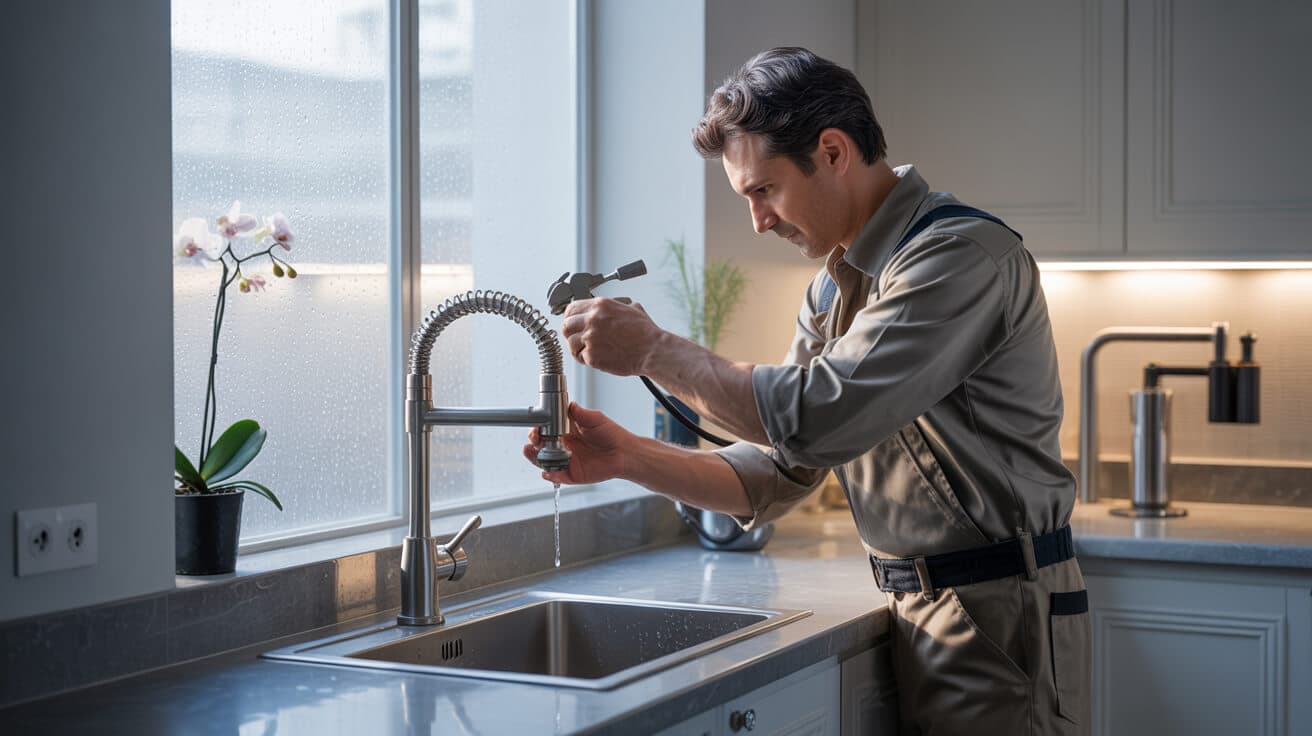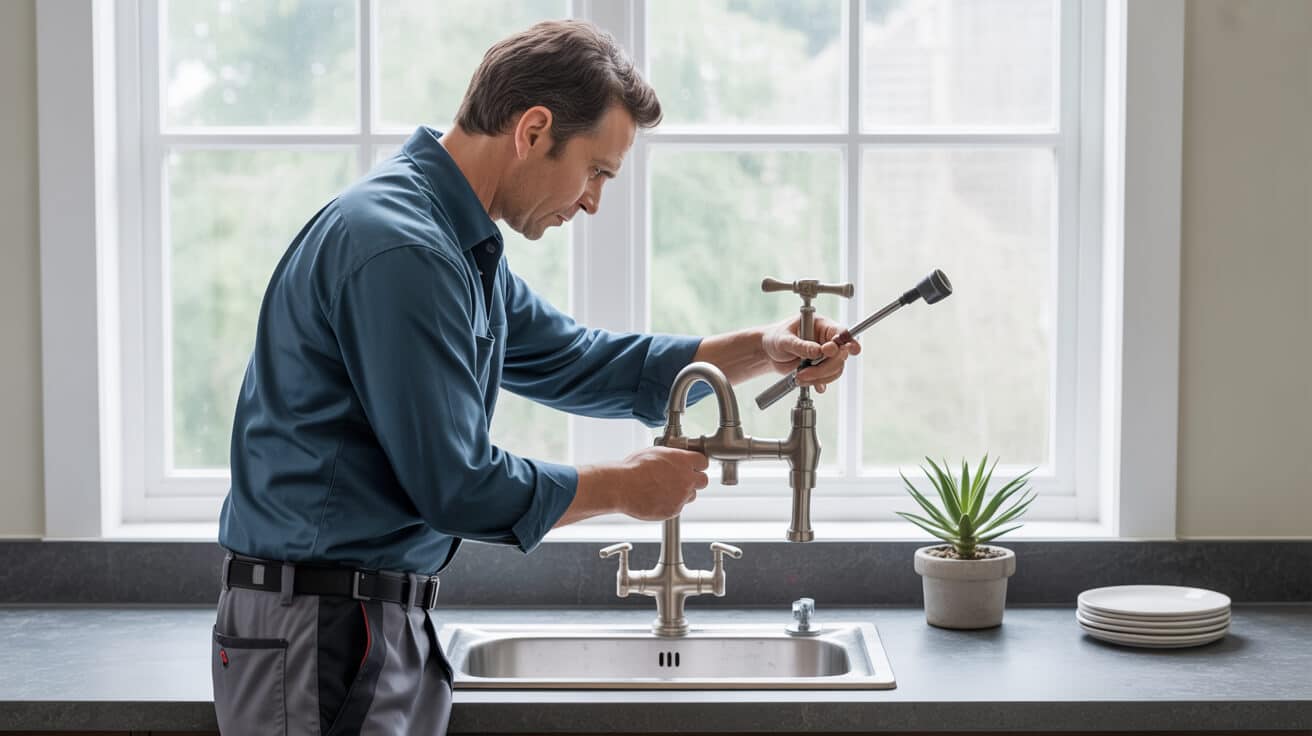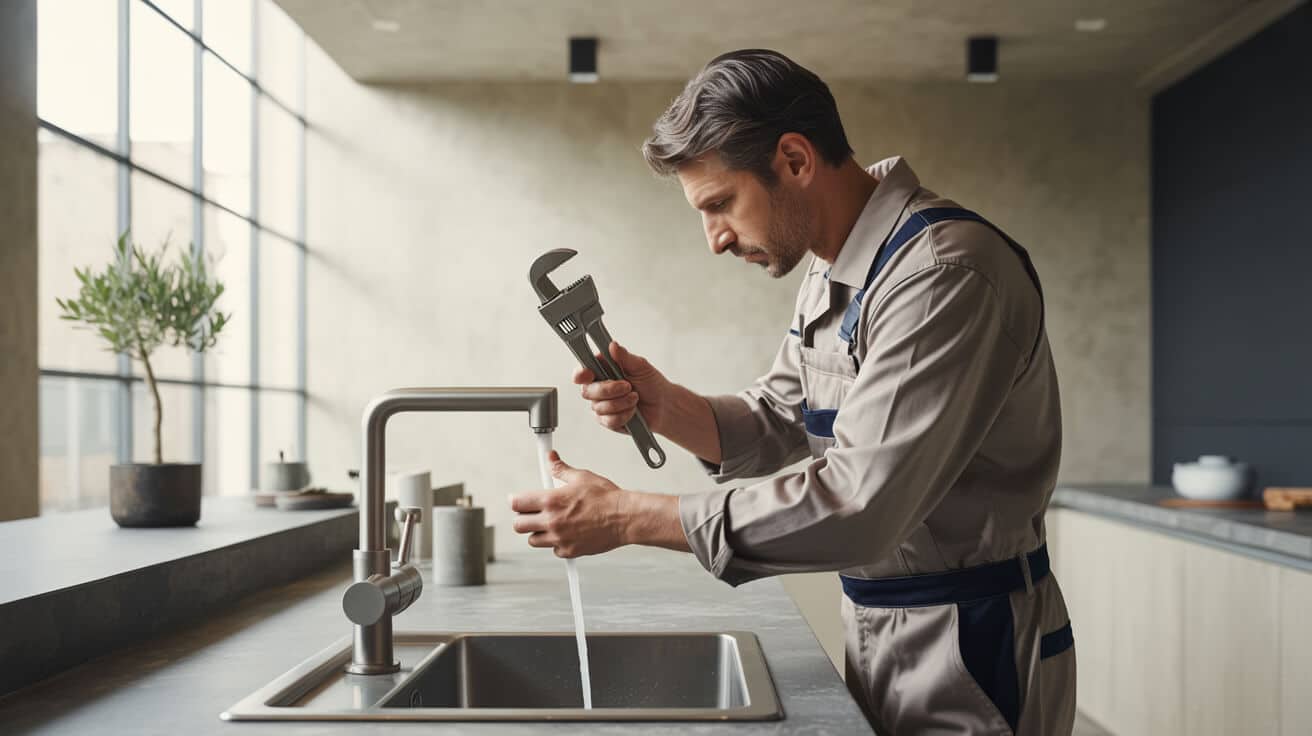A stiff tap is a water outlet valve, such as a basin or kitchen tap, that requires excessive force to operate due to increased internal friction, component misalignment, scale buildup, or wear. The diminished ability to open or close a tap impacts user convenience, increases water wastage risk, and may signal deeper system failures. Reliable remediation ensures your comfort, hygiene, and regulatory compliance, and supports the efficient maintenance of your property or facility.
Etymology or Name Origin
The phrase “stiff tap” is widely used in the United Kingdom to describe a valve, typically a water tap or faucet, that has become hard to turn. Regional variations exist: in North America, the equivalent is a “seized faucet” or “hard-to-turn handle,” whereas Australian documentation might specify “pillar tap resistance” or “jammed mixer.” In technical literature, descriptions include “elevated operating torque,” “valve actuation resistance,” or “impeded tap movement.” The linguistic distinction often emerges in insurance claims, warranty reports, and supplier catalogues, where consistent terminology is important for describing symptoms and sourcing compatible components.
Overview / Context
Water taps are vital endpoints within a building’s potable water distribution, acting as customizable barriers that permit or restrict flow on demand. The challenge of tap stiffness is not limited by geography or property type, yet is unevenly distributed due to variations in water hardness, construction age, and frequency of use. Older buildings or recently renovated properties lacking contemporary fittings are more likely to develop movement resistance as a result of sedimentation, corrosion, or fatigue of internal seals.
Your property’s type influences risk—multi-unit residences and commercial facilities tend to cycle taps more often, accelerating mechanical wear. Environmental variables, such as mineral-rich (hard) water, introduce incremental deposits that aggravate component friction and deterioration. For asset holders such as landlords or facilities managers, tap stiffness often acts as a sentinel event—a minor complaint presaging deeper service needs, hygiene risk, or regulatory scrutiny. In asset-heavy organisations, unaddressed tap stiffness may catalyse water damage, disrupt business operations, or incur legal intervention, especially where statutory maintenance or accessibility standards apply.
History
Origins
Manipulable valves, the ancestors of modern taps, emerged with the advent of pressurised water systems in the nineteenth century. Early domestic taps used threaded brass spindles and rubber washers compressed against stationary valve seats, their simplicity offset by high maintenance frequency as materials degraded and alignment faltered.
Industrial emergence
The industrial revolution saw mass production standardise tap architecture, promoting broader household and industrial water access but revealing persistent friction faults. Municipal hard water delivery, increasingly common in growing cities, worsened mineral buildup. The proliferation of indoor plumbing in the 20th century coincided with industry-wide pivot from full-turn compression taps to ceramic disc (quarter-turn) and cartridge-based designs, intended to minimise wear and extend service intervals.
Contemporary evolution
Modern taps often feature composite assemblies, precision-manufactured components, and anti-scale finishes. Regulatory change, like the 1999 Water Supply (Water Fittings) Regulations in the UK, incentivized tool-free maintenance and the use of WRAS-approved (Water Regulations Advisory Scheme) devices. Today, sensor-activated and thermostatic designs are found in public and high-end settings, requiring more specialised knowledge for diagnosis and repair. Changes in consumer expectation—fewer tolerated failures, higher demand for reliability—have driven more proactive property service models.

Concept / Description
Mechanical structure
Taps comprise several interdependent components:
- Handle: user interface for actuation
- Spindle/Stem: transmits turning force to move internal mechanisms
- Gland nut/Bonnet: secures stem, retains water tightness
- Washer or Cartridge: acts as a movable seal over the valve seat
- O-rings and Seals: prevent leakage along stem and handle
- Body: directs water and houses all other parts
- Aerator: controls flow and minimises splashing
In a compression tap, turning the handle drives the spindle downward, compressing a washer onto the seat. In a quarter-turn ceramic model, rotating the handle aligns two ceramic discs to allow or block flow. Each design distributes wear differently. Abrasive debris or mineral deposits abrade the seat, washer, or disc surface, incrementally increasing friction and resistance.
Failure mechanisms
Component wear, misalignment, and corrosion are the chief mechanical causes of stiffness. Chronic exposure to hard water accelerates limescale formation on moving surfaces, while infrequent use or temperature extremes dry out lubricating greases or shrink polymer seals. Overtightening by users or installation errors (cross-threading, over-compression) can misalign stems, hasten spindle fatigue, or distort cartridge housing—rendering even new taps vulnerable.
Functionality / Purpose / Applications
Taps are engineered to deliver measured, safe, and accessible potable water. Their usability is foundational to hygiene, cleaning, and operational activities in homes, businesses, and public infrastructure. Inaccessible or frozen taps present obstacles for basic living, commercial care, and statutory compliance.
Persistent tap stiffness compromises these functions by:
- Hindering routine personal or operational hygiene
- Increasing the risk of water left running (due to avoidance of forced closure)
- Concealing more significant failures (such as pipe leaks or pressure anomalies)
- Wasting water and eroding energy efficiency
- Escalating maintenance costs by encouraging user-forced component breakage
Asset managers, landlords, and facilities directors recognise that prompt repair mitigates complaint escalation, bolsters safety audits, and anchors effective water management protocols.
Classifications / Types / Variants
Tap diversity influences both the likelihood of stiffness and appropriate remediation:
- Compression pillar/bib taps: Requiring multiple handle turns, relying on compressible washers. Common in legacy housing, especially where infrequent maintenance occurs.
- Quarter-turn (ceramic disc): Minimal handle movement, ceramic disc interface. Favoured for reliability, though sensitive to waterborne grit and require entire cartridge replacement if binding occurs.
- Monobloc mixer: Single outlet blending hot and cold supplies, variants include both compression and cartridge styles.
- Thermostatic mixer: Used for precise temperature control in baths and showers, featuring integrated safety and blending mechanisms.
- Sensor taps: Rely on electronic valve actuation, susceptible to mineral buildup or battery decay but substantially reduce mechanical wear.
- Accessible/adaptive taps: Designed for low-force operation, critical in healthcare and public housing; malfunctions here have heightened compliance implications.
Material distinctions—brass, stainless steel, advanced polymers—can influence susceptibility to certain failure modes.
Systems / Tools / Methodologies
Tool inventory
Professional tap servicing utilises precision and context-specific equipment:
- Adjustable and box spanners: for gland nut or handle removal
- Cartridge pullers: tailored to brand and variant
- Needle nose pliers: , tap re-seaters, and O-ring picks
- Cleaning tools: wire brushes, proprietary descalers, white vinegar
- Lubricants: silicone grease formulated for potable water
- Seal and washer kits: including WRAS-approved rubber and ceramic replacements
- System isolation devices: local isolators, stopcocks, or main water shut-off valves
- Digital torque metres: in commercial settings for compliance measurement
Repair methodology
- Preparation: Identify tap type and gather corresponding resources.
- System isolation: Shut off water supply, depressurize affected line.
- Disassembly: Remove handle, gland nut, spindle, and internal mechanism.
- Inspection: Examine washer, cartridge, spindle, and seat for mechanical wear or deposits.
- Cleaning: Remove debris, scale, and residues.
- Component replacement: Fit new, approved parts as needed.
- Lubrication: Apply minimal potable-grade lubricant to moving interfaces.
- Reassembly: Restore all components, securing to correct torque and alignment.
- Testing: Operate tap to verify restoration of smooth movement and water tightness.
- Documentation: For managed or organisational assets, record intervention for compliance.
DIY vs. professional repair
While the resourceful user may achieve minor mitigation on accessible compression taps (e.g. washer swap), tap types with non-standard cartridges, inaccessible fittings, or commercial documentation needs generally justify calling qualified professionals such as Plumbers 4U. the use of proper tools, compliance parts, and documented warranties differentiates professional intervention from household attempts.

Stakeholders / Entities Involved
Stakeholders and their interests include:
- Homeowners: Direct user experience, property value, and household water efficiency.
- Landlords and property managers: Legal compliance, tenant satisfaction, and maintenance cost management.
- Tenants and residents: Daily quality of life, promptness of repairs, access for children, elderly, or disabled.
- Facilities managers and directors: Large-scale water management, documentation, and scheduled maintenance.
- Plumbing professionals and contractors: Diagnosis, repair execution, warranty, supply chain operations.
- Suppliers and manufacturers: Provision of WRAS and ISO-compliant components, service/support for proprietary mechanisms.
- Regulatory bodies: Standard-setting, enforcement, and inspection protocols to safeguard health and asset integrity.
- Insurers: Risk management and claims assessment following plumbing-related incidents.
Effective systems ensure each party fulfils reporting, documentation, and maintenance duties to prevent risk or dispute.
Legal / Regulatory / Ethical Considerations
Regulatory frameworks
The UK’s Water Supply (Water Fittings) Regulations 1999 require that all installation and remedial work utilise approved, WRAS-listed components and methods, with the intention to prevent potable contamination, interruption, or leakage. Landlord-tenant legislation further demands prompt, verifiable response to reported water faults. Organisational users encounter more complex expectations for scheduled inspections, risk assessment, and documented interventions.
Ethical obligations
Compliant repairs prioritise:
- Personal and user safety (hot water, pressure, isolation)
- Environmental responsibility (minimising water waste)
- Use of safe and certified components (WRAS, ISO, or comparable local standards)
- Transparent documentation, particularly when work affects vulnerable populations or public assets
Insurance/logging
Service records, parts lists, and invoice logs are routinely required by insurance underwriters to validate claims or prove preventive action, protecting your company’s asset value and limiting liability in the event of a water-related dispute.
Performance Metrics / Data / Measurements
Key technical indicators
| Metric | Description | Pre-repair (Typical) | Post-repair (Target) |
|---|---|---|---|
| Operating Torque | Force needed to actuate handle | Elevated | Within manufacturer spec |
| Cycles to Failure | Number of actuations before recurring stiffness | Low (frequent issues) | High |
| Water Loss | Flow bypass from incomplete closure (litre/day) | Elevated risk | Minimised/none |
| Recurrence Rate | Return of fault within 12 months | Common | Rare |
Industry bodies such as WRAS and ISO 3822:2018 (Acoustics) provide reference standards for noise and force measurements. Proprietary data from Plumbers 4U and similar firms offer benchmarks on repeat callout frequency, average time-to-fix, and cost savings across property portfolios.
Challenges / Barriers / Limitations
Issues affecting stiff tap repair span:
- Operational barriers: Concealed pipework, vandal-prone installations, lack of isolation valves, legacy system integration, and seasonality (cold-induced materials shrinkage).
- Technical barriers: Non-standard or obsolete tap designs, unavailable proprietary parts, advanced limescale, or corrosion requiring pipework modification.
- Economic barriers: Cost sensitivity for single-property owners, balance of planned investment vs. repeated reactive callouts, and long-term value retention.
- Social barriers: Inaccessibility for mobility-restricted users, language obstacles in tenant communication, and lack of repair skill within your organisations or small managers.
- Philosophical barriers: Decision-making between restoration for historical preservation and the adoption of contemporary, lower-maintenance solutions for efficiency.
Selecting optimal action (repair versus replacement) often requires weighing present interruption against future-proofing and systemic modernization.
Impact / Influence / Legacy
Timely and compliant tap repair safeguards your daily access to water, reduces long-term consumption, and precludes costly water damage or legal breaches. In residential environments, this enhances tenant retention, satisfaction, and broad community confidence in asset management. For organisations managing a large estate, the reduction in compliance risk, insurance claims, and staff time spent responding to recurrent minor faults builds a foundation for organisational trust and resource stability.
Strategic, data-driven maintenance (scheduling, digital asset logs, supply chain alignment with WRAS/ISO providers) increases property valuation and extends usable lifecycle of core infrastructure. For service providers such as Plumbers 4U delivering documented repairs, engagement with homeowners, landlords, and business operators establishes an ethical commitment to water stewardship and safety.
Future directions, cultural relevance, and design discourse
Improved engineering—anti-limescale cartridges, long-life polymers, and “click-to-fit” designs—reshapes the trade by shifting more maintenance upstream and reducing emergency calls. The increased availability of sensor or hands-free taps signals the growing convergence of hygiene, accessibility, and water-saving imperatives. Legislative momentum is expected to drive further WRAS cert adoption, foster transparent compliance-reporting for landlords, and align with broader sustainability agendas.
Culturally, tap faults have evolved from casual inconveniences to prioritised maintenance items—underscored by water scarcity, cost pressure, and the reputational risk of unsafe or unresponsive service. Communication scripts, aftercare initiatives, and public-awareness campaigns reinforce that your small system decisions, like prompt stiff tap repair, can have a remarkable network effect on your property, organisation, or community.

